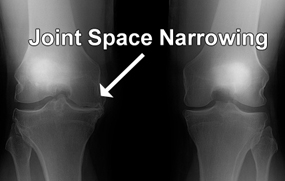In a healthy joint, the joint space and articular cartilages work as shock absorbers and cushion while moving. In cases when the normal articular cartilage wears off, the joint space narrows and the affected joint becomes painful and stiff. The affected joint, as the damage progresses, has a limited range of motion as well. The most common affected joints are those mostly used throughout our life, like the knee, hips, and hands.

What Causes Joint Space Narrowing?
One of the factors which result in narrowing of joint space is the overuse of the joint. Normally, as people get older, the articular cartilage wears off, leading to various problems. Other risk factors contributing to narrowing of joint space include muscle weakness, being overweight or obese, etc.
Some conditions can cause the narrowing as well, including rheumatoid arthritis, osteoarthritis, etc. As the cartilage gets damaged due to inflammation, the pain will accompany any joint movement. The affected joint over time will start to swell and get stiff, and in general, it will be more difficult to move it.
How Is Joint Space Narrowing Tested?
Testing
Certain examinations are needed when testing for narrowing of joint space, including:
- X-ray – It helps visualize any joint damage or space narrowing. This examination is discomfort-free and the results will be ready in just a few minutes.
- MRI – It is an examination which uses radio waves to create images of the joints.
- Ultrasound – It is also an examination which uses sound waves for a closer examination of inner parts of the human body.
Physical Exam
A physical examination of the affected joint is necessary in cases when the narrowing of joint space is suspected. Your doctor will touch and palpate the affected joint in order to check for any changes such as the presence of swelling, redness, cysts, range motility limits, the level of pain or discomfort while moving the affected joint, etc.
Understanding Your Results
Based on the examinations, diagnosis as well as the severity of the damage to the articular cartilage will be determined.
The most visible symptom is abnormally low levels of joint cartilage. Osteophytes, also known as bone spurs can be visualized as well when present. Osteophytes usually appear as a result of the losing cartilage process. Subchondral cysts which are fluid-filled sacs made of joint material can be visualized as well. Your doctor will also look for subchondral sclerosis.
How Is Joint Space Narrowing Treated?
The following are some common treatment options. Consult your doctor for the most suitable treatment for your condition.
1. Oral Pain Medications
Oral pain medications, both over-the-counter medications and prescribed painkillers are recommended. Most common used painkillers are aspirin, acetaminophen, oxycodone, hydrocodone, codeine, etc. These medications work by dulling the pain receptors located in the brain.
2. NSAIDs
Nonsteroidal anti-inflammatory medications (NSAIDs) are very popular and beneficial when it comes to reducing the inflammation of the affected joint and relieving the pain and other symptoms.
3. Steroid Injections
The intra-articular steroid injections can be very beneficial to relieve the inflammation of the affected joint. Cortisone is commonly used, very similar to the cortisone produced in the human body from the adrenal glands. The effect of these steroid injections is long-lasting.
4. Gel Injections
Gel injections are another treatment option in cases of joint space narrowing. A gel-like substance is injected into the affected joint in order to help the joint lubrication, relieving the pain. The gel used for injection can be either from animal or made synthetically.
The main compound of the gel used for such a treatment is hyaluronic acid. It is well known that hyaluronic acid is an important component in the joint fluid. One or several injections are recommended, always depending on the severity of the joint damage and results achieved.
5. Surgery
In cases when all conservative treatment methods have failed to improve and relieve the signs and symptoms, surgical treatment is the last option. Arthroscopy is perhaps the most performed surgical procedure which is also a minimally invasive procedure.
Arthroscopy enables your doctor to look inside the affected joint as well as to treat many minor problems of the affected joint if necessary. In severe cases, even a complete joint replacement is necessary.
